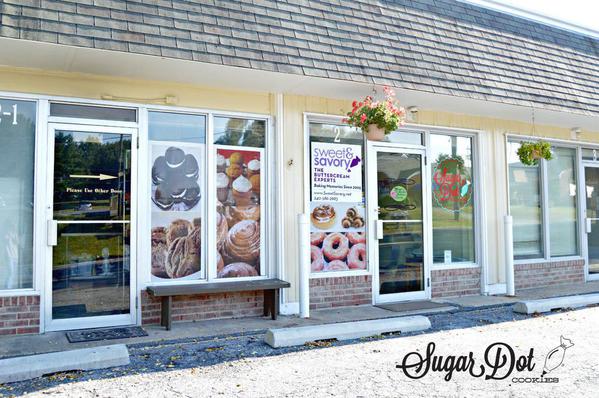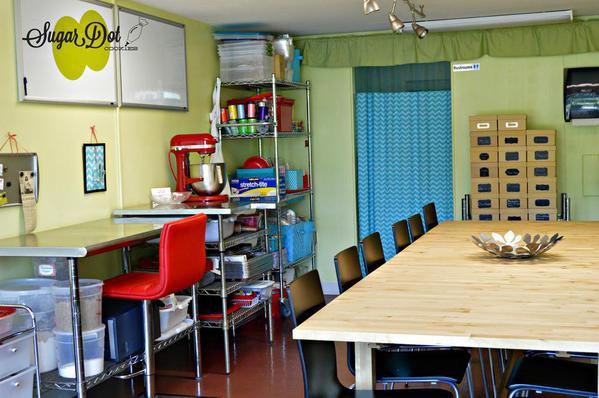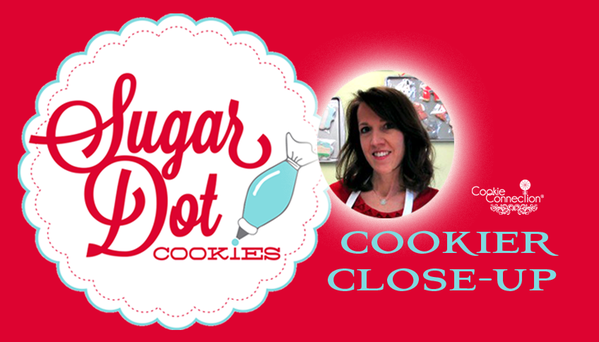Wow! Last month, we had one of the liveliest chats in recent history with Dotty Raleigh of Sugar Dot Cookies, another fabulous CookieCon 2015 instructor. The chat room was buzzing! People came craving solid, practical advice about how to launch their cookie interests into viable businesses, and Dotty was full of it (solid, practical advice, that is!). ![]()
Having moved into shared commercial kitchen space about two and a half years ago, Dotty is successfully making the start-up transition as we speak, and is uncommonly open about revealing her ups and downs, and lessons learned. So, in this interview, it only makes sense to continue where we left off in that chat, with more of Dotty’s business dos and don’ts (plus, some requisite CookieCon questions, of course)!
![]()
JMU: Welcome back to Cookie Connection, Dotty! I’m so glad you’re willing to continue our business discussion here today!
Just to recap your background for readers who weren’t on the chat: Dotty shares kitchen space in Frederick, Maryland, USA with two others - a cake decorator and the bakery owner – and pays a flat monthly fee for working as many hours there as she needs. She started selling decorated cookies part-time in January 2013 out of this same space, since using a commercial kitchen is a requirement for food-service operators in Maryland. But it was only rather recently, in June 2014, that Dotty began working full-time on cookie orders, supplementing them from time to time with one-on-one cookie decorating classes and cookie parties for adults and kids.
The bulk of Dotty’s business comes from pre-ordered decorated cookies, typically purchased online through her site; she doesn’t serve any retail foot traffic at this time.
So, with that introduction, let’s get into some business questions that didn’t get asked during our Saturday chat!
Just to give readers a better sense of the scale of your business, can you tell us how many cookie orders you fulfill, on average, per week? What’s your average order size (in number of cookies and dollar value)? And what percent of those cookies get sold locally versus shipped longer distances? (Guesstimates are completely okay, BTW!)
 The outside of Dotty's shared commercial space.
The outside of Dotty's shared commercial space.
![]()
DR: Yikes! I really don’t keep those kinds of records, and every order and week is so different. The number of cookie orders per week really varies. Sometimes, it will be just two large wedding orders in a week. Other times, it can be maybe six moderate-sized orders.
I consider an order of 24 cookies to be a small one. (That also happens to be my minimum for an order.) Most often, I’d say that an order is from 50 to 100 cookies.
Dollar value? Gosh, I don’t know what the average would be. I’ll just look at last month (July) and see what we did. The smallest order was for $96. Most orders were in the $100 to $250 range. One was at $581, and another was at $750.
I don’t happen to know the percent of shipped versus local, so let’s again take a look at July. I had 70 percent local pickups and 30 percent shipped. I’d say that’s probably pretty typical. I definitely do more local business.
![]()
JMU: Sorry, I didn't mean to put you on the spot, but that context was super helpful! Thanks so much!
From the chat, it sounded as if finding your shared space was almost by chance, but perhaps it wasn’t . . . how long did it take to first find that location in 2013? And how did you go about searching for and selecting a space?
![]()
DR: It was fate! It took a few months to find the space. I called around – everywhere I could think of that had a commercial kitchen. I got lucky with one call when the woman (now my landlady) told me that she was getting ready to open a bakery and was open to the idea of renting time to me.
![]()
JMU: Why did you decide to rent versus buy your own space?
![]()
DR: Money, of course! I had no interest in taking out a loan and plunging a lot of money into this business idea that I really didn’t know would work. Renting was the least expensive, and only realistic, option for me.
![]()
JMU: And why did you decide to share space versus renting a space on your own? I can see a few pluses and minuses to either scenario.
![]()
DR: Money again! It’s much more affordable to share!
![]()
JMU: Well, that was an easy answer! I started out with a shared rental agreement too, largely to keep costs down as well. But I'm sort of a control-freak (as if that wasn't obvious), so I had a hard time sharing space and equipment with others. I abandoned the idea about three months into it, after struggling one too many times with frosting cakes near blazing ovens! Anyway, I digress . . .
To sum up our location discussion, what advice would you give to cookiers who are seeking their first commercial location? What are the top three things that make a good cookie location? Would you recommend that cookiers share space at the outset, or go it alone?
![]()
DR: Call every place you can think of. Get creative. There are kitchen situations that you might not have thought of.
“Location, location, location.” That’s what they say, right? Well, that doesn’t happen to be true for me. My kitchen space is in a smallish town on a side street with little traffic, but this works perfectly for me. The rent is lower. I don’t keep cookies in stock for walk-in purchases, so I don’t really need the visibility. So for me, it’s not the location that makes it right; it’s:
- Price. Obviously, the space has to be affordable, or you won’t be in business long.
- Equipment/Appliances. The space has to have a large oven, refrigerator, freezer, and sinks.
- Time. You have to be able to spend the time there that you need to make it work. We all know how much time cookie decorating can take!
Shared space or go it alone? Obviously, I chose to share a space. I wasn’t willing to take the financial risk of going it alone. I would recommend starting with the least expensive way possible. Make that work. Grow your business. Then consider venturing out on your own. But I know of many cookiers and bakers who started with their own places and have been very successful, so both ways work!
![]()
JMU: Is there a “best” way to structure a shared space agreement like yours? What are some of the key considerations that go into crafting such an agreement? For instance, do you have a contract that stipulates who can use certain areas of the building or equipment at certain times? Do you have to use your own equipment, or are you sharing equipment as well? Who’s responsible for any breakage or damage to the property or shared equipment?
![]()
DR: Our agreement is very informal. The three of us work around each other really well. Most of my time is spent sitting in a chair decorating. I do that in the front room so that I’m out of their way in the kitchen. I usually bake early in the morning. The other two ladies usually bake later in the day, so they’ll check with each other to arrange their kitchen use.
There are no contracts about areas, equipment, or time. All of the major equipment and appliances (oven, fridge, freezer, sinks) are owned by the bakery owner. We can use them any time we’d like. Each of us has our own small appliances and our own supplies (mixers, cookie sheets, measuring cups, etc.). We also have our own ingredients that we keep separate. And all three of us carry liability insurance, just in case there are any major problems.
![]()
JMU: Is negotiating a flat monthly fee for shared space the best way to go in all circumstances? Or are there conditions where an hourly rate or some other payment structure might be better for the person leasing the space?
![]()
DR: I didn’t start out paying a flat monthly fee. That started when I went full-time. When I first started, I paid in cookies! The bakery was open to walk-ins at that time. When I worked on an order, I would make extra to leave for the bakery owner to sell. Pretty sweet deal, huh? If you can find a way to barter for your rent, all the better.
An hourly rate never would have worked for me. Most commercial kitchens rent for $25 to $30 per hour. I don’t know how I’d make a profit paying that kind of rent. The monthly rate works out much better! I compare it to paying hotel rates versus renting an apartment. Paying per month is much more manageable than paying per night!
![]()
JMU: You've certainly been resourceful; there's no doubt about that! More on sharing space (obviously, I'm still trying to wrap my head around how it has worked so seamlessly for you! ![]() ) . . .
) . . .
Before launching headfirst into a shared space agreement, what are the three most important things to know about the partners who will be sharing the space with you? And . . . the same question about the person who will be leasing the space to you, if those people are different.
![]()
DR: I’m fortunate that I knew the bakery owner prior to moving in full-time, since I had been with her for a year and a half when I was part-time. I liked and trusted her. I knew that we’d work well together, help each other out, and have fun. I knew that she was professional, organized, and tidy. I also knew the wedding cake lady prior to her coming on board. (Though I have no say in who rents. That’s totally up to the owner.) All of the above characteristics are fortunately true for her too.
That was more than three things!
 Special Washington DC-themed wedding set (you'll learn more about it in a bit)!
Special Washington DC-themed wedding set (you'll learn more about it in a bit)!
![]()
JMU: That's okay - all great info! So let’s turn to pricing, as setting price seems to be problematic for a lot of people. You mentioned (emphatically!) in the chat that you are not a fan of volume discounts. (“Never, ever, ever!!!! More ingredients, more supplies, more time.") Thank you, BTW, for reinforcing a position that I also feel very firmly about! ![]()
You also indicated that you commanded $7 per cookie for some of the cookies in your largest-ever cookie order ($2000) for a wedding. (Folks, those cookies are pictured directly above.)
So, how do you handle the inevitable price-shopping customer who says. “What?! $7 for a decorated cookie?! You’ve got to be crazy!” ![]() Any tips for our readers about how to hold their ground?
Any tips for our readers about how to hold their ground?
![]()
DR: I’ve never actually faced that situation. I’m sure many people think that, but they’ve never said it in that way. I very often don’t hear back after giving a price quote. Sometimes they’ll reply with, “That’s out of my budget,” or “That’s more than I wanted to spend.” I totally respect that. Decorated sugar cookies AREN’T in everyone’s budget and that’s okay. I respond with, “I completely understand. Thanks for letting me know.” A few times, people have let me know that they found the cookies at a lower price elsewhere. That’s fine too. They receive the same response from me.
I think it helps that my website gives an idea of my pricing. I assume that if price is an issue, they take a look at my pricing before contacting me.
And for the record, $7 is my highest-priced cookie, and that’s only for a few designs. Most of my regular-sized cookies are $4 to $5 each. Minis are usually $2 each.
My advice when handling those with sticker shock is to reply respectfully. Keep it short. No need to explain yourself or your pricing structure. Don’t apologize. Certainly don’t give a discount. If the situation warrants, you could offer them other design or size options that would be less expensive.
![]()
JMU: Great advice coming from a consummate professional! So, you mentioned a bunch of prices for different cookie designs and sizes. How did you go about setting those prices? Did you take a cost-based or market-based approach, or some combination of the two?
![]()
DR: As a child, I would often ask my dad some obscure question, let's say about rock formations. And he would tell me, “Sorry, I missed that day at geology school.” So, Julia, I’m afraid that I missed that day at business school. Ha ha. I’m no expert (by a long shot) on pricing structure. I’ve read posts on Cookie Connection about ways to figure costs and pricing. I’m afraid that I’ve never gotten that technical. My highest payout per month is my rent. My other costs, comparatively, aren’t that much. My main concern is always being paid for my time. I want to look at each month’s numbers and see that I’ve made a fair monthly wage after subtracting my expenses paid out. I even break that number down to see my weekly, daily, and hourly average pay. I’ve raised my prices a few times when I saw that those numbers weren’t where I wanted them to be.
So, my prices aren’t based on market supply and demand, or what anyone else is charging. And they’re not exactly based on total cost plus some profit margin, though I suppose that would be the more accurate way. If I were to look at it that way, then my time is my highest monthly cost, and I should be adding a profit margin on top of that.
(Phew. That was a toughie. Any business types are cringing right now.)
![]()
JMU: LOL. No, not cringing here . . . having surplus funds (aka real "profit") after paying yourself is, coincidentally, something that Michelle Green spoke a lot about in her recent Cookie Connection post. A surplus helps with cash flow management and can fuel growth through investments. But if cash flow isn't an issue or growth isn't an immediate priority at the moment, then breaking even, after paying oneself a decent wage, is certainly viable. I've known of many food-service businesses where owners didn't draw salaries for months at a time in order to make ends meet, so you are way ahead of them! ![]()
You mentioned in the chat that you use Wave to track your business income and expenses. How does it compare to other popular small business accounting software, like QuickBooks, for instance? Do you also use it for helping to set prices? Would you recommend Wave to other cookiers? Why or why not?
![]()
DR: I can’t compare it to anything else, since it’s the only thing I’ve ever used. I do love it and recommend it all the time. It does not help to set prices. But . . . it’s free. Boom!
I use it to send invoices that look very professional. Customers make credit card payments through those invoices. (There is a credit card processing fee, of course.) I enter all of my expenses there. (I actually kind of enjoy doing that. No more piles of receipts hanging around. I enter them every few days.) I can view reports for any time frame chosen (income minus expense, expenses broken down by category, etc.). Tax preparation takes no time at all with the reports! It’s all done online.
![]()
JMU: Wow, it sounds awesome!
You mentioned earlier that you ship about 30 percent of your cookies. How do you determine how to price the packaging, as I know from my past bakery experience that the time to bag and tie cookies (or heat-seal them) can rapidly add up.
![]()
DR: Well, once again, no real formula. And, once again, it’s my time that is the biggest factor. Buying bags and ribbon in bulk keeps that cost down. For shipping/packaging, I charge $0.25 each for the bags/curling ribbon, plus the actual shipping rate, plus insurance, plus a few dollars for other supplies, such as bubble wrap, the bakery box, etc. It seems to work out just fine.
Truth be told – I have a secret weapon. My parents! They often bag cookies for me! I “pay” them in messed up and extra cookies.
![]()
JMU: Ahh, more creative bartering, I see! ![]() Any tips for our readers for packaging for zero breakage?
Any tips for our readers for packaging for zero breakage?
![]()
DR: I read lots of tutorials and hounded my cookie friends Amy and Cindy before I got up the courage to start shipping. Thanks to them, I’ve had great success in the breakage department. I wouldn’t say “zero” though. I have been told a few times that one or two cookies arrived broken. I recently wrote a blog post about how I pack for shipping. Readers can find it here.
![]()
JMU: Great, thanks for that tip-laden link! I’m also curious to know a little more about your teaching. Roughly what percent of the time are you teaching versus prepping for/hosting cookie parties, versus fulfilling cookie orders?
 The front of Dotty's shared space, where she holds her parties and decorating classes.
The front of Dotty's shared space, where she holds her parties and decorating classes.
![]()
DR: I hold one adult cookie decorating party per month. I’ve only hosted about six kids' birthday parties. Both types of parties are two hours. Many hours of prep and cleanup go into parties.
The one-on-one classes vary. I’ve done zero to three per month. They last for two or three hours. The prep and cleanup are much lighter for these. The rest of my time is spent fulfilling cookie orders.
![]()
JMU: Just curious . . . why did you choose a one-on-one model for teaching rather than a group model? Aren’t the set-up costs for one person nearly the same as for a small group, and, therefore, wouldn’t a small group class be the more profitable undertaking?
![]()
DR: I’ve taught several group classes. It took me a while to realize that most of the people who attended were merely looking for an enjoyable evening out. They weren’t there because they were serious about learning to decorate cookies. Imagine that! I was taking it very seriously. I had a whole long spiel to start the class. I came up with new techniques for each class. It finally occurred to me to lighten up, and keep things casual and fun. Make it a party by keeping the teaching part brief. If someone wants to really learn, they’ll contact me for a class.
I don’t hold group classes any more, mainly because I don’t know that I could fill one up with people who really want to learn and would pay more.
I charge $43 per person for a two-hour party. The maximum is 12 people. I charge significantly more (like four times more) for a one-on-one two-hour class. I feel that I can charge that much because the student has my undivided attention. The class is based on what the student wants to learn. I sit and decorate with that person the whole time and answer every question s/he has. At this point, I couldn’t charge that much per person if I was teaching a group. Teaching group classes is not out of the question though. That would be something to explore later if the interest is there.
![]()
JMU: Wow - you've really thought about every angle! I tend to be very numbers-driven, but there's so much more to any business decision than just the numbers!
Tell me now, what are your biggest lessons learned from teaching? That is, what advice would you pass onto readers who are aspiring to teach classes, or to grow their teaching businesses?
![]()
DR: I would suggest starting small. Start with a two-hour group class. Have the cookies baked and the icing bagged. Keep the designs simple for beginners. Once you have that down, you may want to hold three-hour classes where you make/color/bag the icing together.
And as always, price to make a profit! Consider all of the hours that go into making the cookies and icing. It takes forever to bag enough icing for 12 people and get set up. There’s also the cleanup afterwards.
![]()
JMU: Oh yeah, never forget to account for the dreaded cleanup! ![]() On another teaching note, can you give us a sneak peek into what you’ll be teaching at CookieCon? (Pretty please!)
On another teaching note, can you give us a sneak peek into what you’ll be teaching at CookieCon? (Pretty please!)
![]()
DR: My main focus will be the whole commercial kitchen aspect. I’ll be talking about creative ways to find a kitchen. I’ll also talk about pricing, streamlining production, staying organized . . . and I have formulas to help figure out how much dough and icing you need for an order. Can’t wait for CookieCon!
![]()
JMU: Sounds terrific! Students are going to eat up your class, I'm sure! Lastly, how do you see Sugar Dot Cookies changing in the next three years or so? What do you want it to become? Do you have a business plan that charts out a deliberate path, or are you taking a more organic approach to see where today’s experience leads you?
![]()
DR: Definitely an organic approach! I’d like to do more of anything that involves other people!
I love teaching the one-on-one classes and really hope to do much more of them. The ladies that come to me for those are always so enthusiastic, eager to learn, and full of questions. (Just like me in the beginning!) They’ve already watched videos and read tutorials online. They just need someone in person to show them. I have a lot of fun being that person!
I’ve done a few demos in the past year. I would love to do more of those also. I sit and decorate while people come by to watch and ask questions. So fun!
Expanding my blog is also something I’m working toward. I’ve recently started writing posts about the business side of cookie decorating. I would like to continue to do that, and much more of it!
As a practical matter, I’ve considered hiring someone to make dough and cut out shapes. I would be able to take on more orders if I had someone helping me with some of the prep.
I suppose that I’ll just wait and see what happens. Opportunities have arisen for me that I never would have dreamed of. Teaching at CookieCon is one example! (Nothing came of another recent crazy opportunity. A third and quite amazing one will come about late November. I think. I hope. Crazy, I tell ya!) So we’ll see what the future holds for Sugar Dot Cookies!
Thank you so much, Julia, for the chat and this interview. I’m really excited about teaching other cookiers about the business side. I hope that I can be a help and source of encouragement to them.
![]()
JMU: Oh, I am sure you will be! You've already been a tremendous help here on Cookie Connection! I wish you much continued success and a wonderful CookieCon!
All cookies and photos by Dotty Raleigh.
Interested in learning more about Dotty? Of course you are! Please check out her site and Facebook page, and be sure to attend her business session at CookieCon!

Cookier Close-ups is the place on Cookie Connection where we celebrate the change-makers of the cookie decorating world. Whether forging new enterprises, inventing novel decorating techniques, or consistently charming us with their cookie decorating prowess, each of our featured thought leaders has redefined in his/her distinctive way how we interact, create, or otherwise do business here in cookie space!
If there are other cookiers you'd really like to get to know, please post requests in this forum. We'll do our best to round them up for an upcoming Cookier Close-up! Thanks!












Comments (7)